- Clone
- S18009D (See other available formats)
- Regulatory Status
- RUO
- Other Names
- T200, Ly-5, LCA
- Isotype
- Rat IgG2a, κ
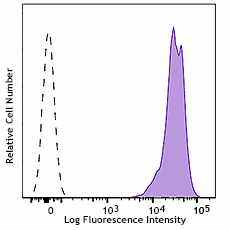
-

C57BL/6 splenocytes were stained with purified CD45 (clone S18009D) (filled histogram) or purified rat IgG2a, κ isotype control (open histogram), followed by anti-rat IgG PE. -

C57BL/6 mouse frozen intestine section was fixed with 4% paraformaldehyde (PFA) for 10 minutes at room temperature and blocked with 5% FBS for 30 minutes at room temperature. Then the section was stained with 10 µg/mL of purified anti-mouse CD45 (clone S18009D) overnight at 4°C, followed by 2.5 µg/mL of Alexa Fluor® 647 anti-mouse IgG (clone Poly4054) (red) for two hours at room temperature. Nuclei were counterstained with DAPI (green). The image was captured by 10X objective.
| Cat # | Size | Price | Quantity Check Availability | ||
|---|---|---|---|---|---|
| 160302 | 500 µg | $218.00 | |||
CD45 is a 180-240 kD glycoprotein also known as the leukocyte common antigen (LCA), T200, or Ly-5. It is a member of the protein tyrosine phosphatase (PTP) family, expressed on all hematopoietic cells except mature erythrocytes and platelets. There are different isoforms of CD45 that arise from variable splicing of exons 4, 5, and 6, which encode A, B, and C determinants, respectively. CD45 plays a key role in TCR and BCR signal transduction. These isoforms are very specific to the activation and maturation state of the cell as well as cell type. The primary ligands for CD45 are galectin-1, CD2, CD3, CD4, TCR, CD22, and Thy-1.
Product Details
- Verified Reactivity
- Mouse
- Antibody Type
- Monoclonal
- Host Species
- Rat
- Immunogen
- Recombinant mouse CD45
- Formulation
- Phosphate-buffered solution, pH 7.2, containing 0.09% sodium azide
- Preparation
- The antibody was purified by affinity chromatography.
- Concentration
- 0.5 mg/mL
- Storage & Handling
- The antibody solution should be stored undiluted between 2°C and 8°C.
- Application
-
FC - Quality tested
IHC-F - Verified - Recommended Usage
-
Each lot of this antibody is quality control tested by immunofluorescent staining with flow cytometric analysis. For flow cytometric staining, the suggested use of this reagent is ≤ 0.125 µg per million cells in 100 µL volume. For immunohistochemistry on frozen tissue sections, a concentration range of 5.0 - 10 µg/mL is suggested. It is recommended that the reagent be titrated for optimal performance for each application.
- Product Citations
-
- RRID
-
AB_2876568 (BioLegend Cat. No. 160302)
Antigen Details
- Structure
- Protein tyrosine phosphatase (PTP) family, 180-240 kD
- Distribution
-
All hematopoietic cells except mature erythrocytes and platelets
- Function
- Phosphatase, T and B cell activation
- Interaction
- Mesenchymal Stem Cells, B cells, Dendritic cells, Tregs
- Ligand/Receptor
- Galectin-1, CD2, CD3, CD4, TCR, CD22, Thy-1
- Cell Type
- B cells, Dendritic cells, Mesenchymal Stem Cells, Tregs
- Biology Area
- Cell Biology, Immunology, Innate Immunity
- Molecular Family
- CD Molecules
- Antigen References
-
- Barclay A, et al. 1997. The Leukocyte Antigen FactsBook Academic Press.
- Trowbridge IS, et al. 1993. Annu Rev Immunol. 12:85-116.
- Kishihara K, et al. 1993. Cell. 74:143-56.
- Pulido R, et al. 1988. J Immunol. 140:3851-7.
- Gene ID
- 19264 View all products for this Gene ID
- UniProt
- View information about CD45 on UniProt.org
Other Formats
View All CD45 Reagents Request Custom Conjugation| Description | Clone | Applications |
|---|---|---|
| Purified anti-mouse CD45 | S18009D | FC,IHC-F |
| Alexa Fluor® 647 anti-mouse CD45 | S18009D | FC,IHC-F |
| Alexa Fluor® 488 anti-mouse CD45 Antibody | S18009D | FC,IHC-F |
| Alexa Fluor® 594 anti-mouse CD45 | S18009D | IHC-F |
Compare Data Across All Formats
This data display is provided for general comparisons between formats.
Your actual data may vary due to variations in samples, target cells, instruments and their settings, staining conditions, and other factors.
If you need assistance with selecting the best format contact our expert technical support team.
-
Purified anti-mouse CD45
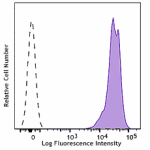
C57BL/6 splenocytes were stained with purified CD45 (clone S... 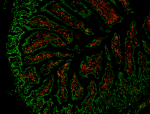
C57BL/6 mouse frozen intestine section was fixed with 4% par... -
Alexa Fluor® 647 anti-mouse CD45
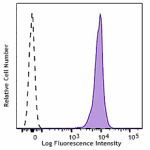
C57BL/6 splenocytes were stained with CD45 (clone S18009D) A... 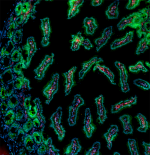
C57BL/6 mouse frozen intestine section was fixed with 4% par... -
Alexa Fluor® 488 anti-mouse CD45 Antibody
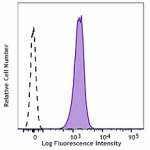
C57BL/6 splenocytes were stained with CD45 (clone S18009D) A... 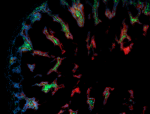
C57BL/6 mouse frozen intestine section was fixed with 4% par... -
Alexa Fluor® 594 anti-mouse CD45
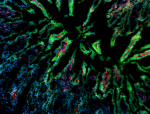
C57BL/6 mouse frozen intestine section was fixed with 4% par...
